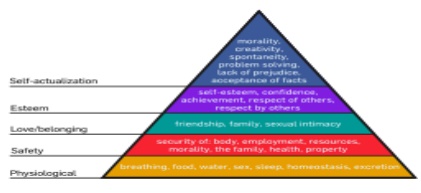Chapter: Mechanical : Human Resource Management(HRM) : Sustaining Employee Interest
Motivation theories

Motivation
theories
An interpretation of
Maslow's hierarchy of needs, represented as a pyramid with the more basic needs
at the bottom.
Motivational theories
are split into two groups as process and content theories. Content theories
endeavor to name and analyze the factors which motivate people to perform
better and more efficiently while process theories concentrate on how different
types of personal traits interfere and impact the human behavior. Content
theories are highly related with extrinsic rewards, things that are concrete
like bonuses and will help improve employees' physiological circumstances
whereas process theories are concerned with intrinsic rewards, such as
recognition and respect, which will help boost employees confidence in the work
place and improve job satisfaction.
A famous content theory
would be Maslow's Hierarchy of Needs, and a famous process theory would be the
equity theory.
Theories of motivation
provide a theoretical basis for reward management though some of the best known
ones have emerged from the psychology discipline. Perhaps the first and best
known of these
comes from the work of
Abraham Maslowbespyramid.Masl comprising a series of layers from at the base
the most fundamental physiological needs such as
food, water, shelter
and sex, rising to the apex where self-actualisation needs included morality
and creativity. Maslow saw these levels of needs being fulfilled one at a time
in sequence from bottom to top. Employment and the resources it brings
workplace may also contribute to a sense of ŌĆŚ the need-esteemŌĆśforŌĆŚse(lfevel
4).
Frederick
HerzbergŌĆśs-hygiene motivatortheory,first published job satisfaction or
dissatisfaction is influenced by two distinct sets of factors and also that
satisfaction and dissatisfaction were not at opposite ends of the same
continuum but instead needed
to be measured
separately. The two sets of factors are motivator factors and hygiene factors.
According to Herzberg, real motivation comes from the work itself, from
completing tasks, while the role of reward is to prevent dissatisfaction
arising. Expectancy Theory is the theory which posits that we select our
behaviour based on the desirability of expected outcomes of the action. It was
most prominently used in a work context by Victor Vroom who sought to establish
the relationship between performance, motivation and ability and expressed it
as a multiplicative one ŌĆōwhere performance equals motivation x ability. There
are a lot of attractions for this kind of approach, particularly for employers
who can target their motivation effort and anticipate a definable mathematical
return for them. As this is a cognitive process theory it relies on the way
employees perceive rewards These three theories plus variants of them have been
used in countless research studies and continue to inform the practice of
reward management up to the present day.
Job
evaluation
Job evaluation is closely related to reward management. It is
important to understand and identify a job's
order of importance. Job evaluation is the process which job's are
systematically assessed to one another within an organization in order to
define the worth and value of the job, to ensure the principle of equal pay for
equal work. In the United Kingdom, it is now illegal to discriminate worker's
pay levels and benefits, employment terms and conditions and promotion
opportunities Job Evaluation is one method that can be adopted by companies in
order to make sure that discrimination is eliminated and that the work
performed is rewarded with fair pay scales. This system carries crucial
importance for managers to decide which rewards should be handed out by what
amount and to whom. Job evaluation provides the basis for grading, pay
structure, grading jobs in the structure and managing job and pay relativities.
It has been said that
fairness and objectivity are the core principals using an assessment of the
nature and size of the job each is employed to carry out.
There also many
different methods of job evaluation which can be used, but the three simplest
methods are ranking, classification and factor comparison. However, there are
more complex variations of methods such as the point method which uses scales
to measure job factors. This method does not not rank employees against one
another but looks at the job as a whole. A disadvantage of these methods of job
evaluation are that they are very static and it would be very difficult to
perform a job evaluation quickly if it was needed.
An advisory company
named ACAS stated that there were five main reasons why employers look at
performing a job evaluation. These include: When deciding on a pay scale:
Making sure that the current system is fair and equal for employees, Deciding
on benefits such as bonuses,Comparing pay against other companies and reviewing
all jobs after a major company pay change . Employees need to feel that they
are being paid a fair wage compared to the same job with the competition. If
this is true it may help reduce staff turnover which is very beneficial for
employers as it reduces the cost of hiring new staff.
Research regarding job
evaluation has mainly been conducted using qualitative data collection methods
such as interviews, large scale surveys and basic experimental methods.
Therefore, there is a large gap for research on job evaluation collecting
quantitative data for a more statistical analysis. A comparison between public
and private sectors and the methods of job evaluation is another area that
should be considered for further research.
Related Topics